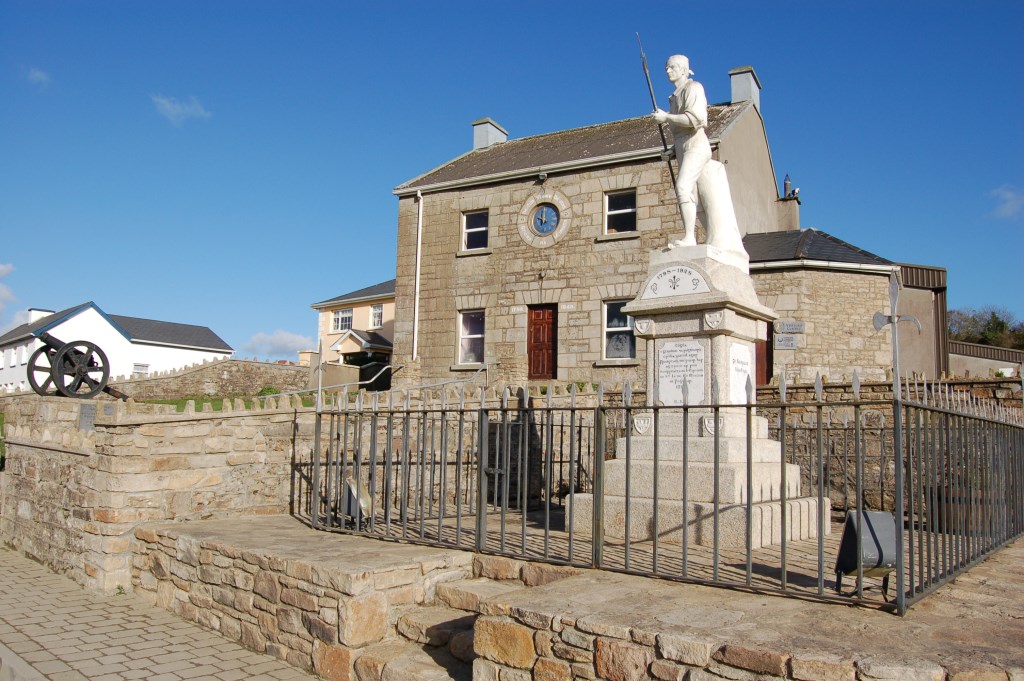Ballinamuck Visitor Centre
Ballinamuck Battlefield 1798 Visitors Centre in the village of Ballinamuck is located in the middle of the site of a battle fought on 8th September 1798. It was the last pitched battle on Irish soil and was one of the final episodes in the 1798 Rebellion.
That rebellion had been organised by the United Irishmen – a secret revolutionary organisation dedicated to winning Irish freedom. At Ballinamuck, a Franco-Irish force, commanded by General Humbert, was defeated by British troops under the command of General Lake and Lord Cornwallis.

Humbert and his 1019 men had landed at Killala Bay, Co. Mayo on 23rd August. They were joined by some Irishmen and after capturing Castlebar, they intended to move eastwards, gain more local support and attack Dublin.
However, British forces were massing to stop them. Humbert’s army marched northeast, through Sligo and into Leitrim with General Lake’s force pursuing them. By the time the French and Irish camped at Cloone, Co. Leitrim on the night of 7th September, Lake was close behind and Lord Cornwallis and his army were shadowing them, having reached nearby Mohill.
Humbert decided to stand and fight at Ballinamuck on 8th September. As you face the pike-man statue at Ballinamuck Visitors’ Centre, you will see Shanmullagh Hill behind the centre. It was there that Humbert halted. The rear of his army was on Kiltycreevagh Hill, which is northwest of village.
The brief first action of the battle occurred at Kiltycreevagh and ended in the surrender of some of the French. General Blake, the principal Irish commander, Gunner McGee and others engaged the British close by, but soon withdrew to the Black Fort, near the road to Gaigue Cross on the south side of Ballinamuck.
Meanwhile, Humbert had retreated to the eastern side of Shanmullagh Hill, away from the enemy, which was attempting to ascend it. As the British mounted a major attack on Shanmullagh, Humbert surrendered. The final action of the battle was the last stand of Gunner McGee and his comrades.
When their one remaining cannon was damaged by British artillery, McGee’s men held it up themselves in order to fire it. They were soon overrun. Due to his bravery McGee is remembered as one of the heroes of the battle. He was reputedly born near Longford town and served as a gunner in the Longford Militia before deserting to join the rebels at Castlebar.
Following the surrender, the French were treated as prisoners of war, but the Irish were shown no mercy: General Blake, Gunner McGee and others were immediately hanged, and many more were killed as they attempted to escape the battlefield.
It has been estimated that the Irish and French had a combined total of 2500 men. Of those about 500 Irish and an unknown, though probably small, number of French died that day. The British lost roughly 150 of a force of close to 30,000. Many of the Irish were buried on Shanmullagh Hill.
Blake was buried in Toberpatrick Cemetery. The Garden of Remembrance in the centre of Ballinamuck commemorates those who died in the battle.
The Ballinamuck Battlefield 1798 Visitors Centre has an interesting exhibition on the battle. The Ballinamuck Battlefield Visitors Centre is open by request. Contact details are 00353 87 9613312, email ballinamuck1798@gmail.com and for further information see discoverireland.ie/ballinamuck-visitor-centre
If you fancy a stroll whlile in the Ballinamuck area, you could visit the Edenmore Bog Walk. Check out Trails.
We are here ↓




